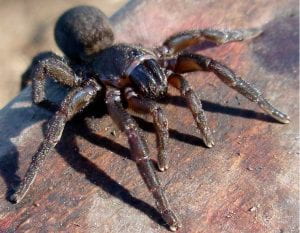Guest Author – Dr Rachel Kruft Welton
Palaeobiology MSc Graduate
It is possible, if you have never lived in Australia, that you have never come across a brush-footed trapdoor spider. These beauties are abundant in Australia and can be found from the tropical rainforests to intertidal coastal regions to the dry interior. They live in shallow burrows, often with a double front door, and some are known to climb trees where they make burrows in suitable cracks and cervices.
They are mygalomorph spiders, which means they are active hunters with vertical biting chelicerae. The brush-footed (aka brushed) trapdoor spiders, Barychelidae, are a sister group to the better known and more feisty tarantulas, and larger species can be easily mistaken for them.

Brush-footed trapdoor spiders have several distinguishing features, not all of which I will bore you with here. They can be distinguished from other mygalomorph spiders by their body proportions, i.e., relative leg lengths, tibia to tarsal lengths, paired tarsal claws, and distribution of hairs (setae), amongst other characteristics.
Brush-footed trapdoor spiders have collections of bristles on their feet which allow them to climb up surfaces so smooth that Spider-man himself would need a ladder. Each hair interacts at the molecular level with the environment around it, creating tiny electrical attractions called van der Waals forces. These act to attach the spider to a surface.
The strength of the forces is additive and increases with the number of bristles of the tufts. Strength is further enhanced by tiny micro-hairs on each bristle. The cumulative effect can allow some spiders to hang upside down with prey as heavy as themselves clamped in their jaws.

The Australian fossil record is, unfortunately, very patchy, and by patchy I mean virtually invisible. Only four fossil spiders have been described from the continent to date, and only two of these are mygalomorph spiders. The evolutionary history of these spiders is still very obscure, so the recent description of a brush-footed trapdoor spider (McCurry et al. 2023) dating from the Miocene is very exciting.
The fossil is 11 to 16 million years old, and dates to a time when the west coast of Australia was drying out, changing from rainforest to a more arid environment. The fossil is exceptionally well preserved, and comes from McGrath’s Flats, a lagerstätte in New South Wales, 200km NE of Sydney.

McCurry et al. used a scanning electron microscope to intimately investigate the fossil, which was so exquisitely preserved that individual setae could be identified. The body proportions allowed the spider to be placed confidently within the Barychelidae, and they named the new species Megamonodontium mccluskyi.
However, there was a problem. This ancient brush-footed trapdoor spider does not have furry feet, whereas every extant species of Australian Barychelid spider do have tufty toes. This fossil must belong to a more basal lineage.
A little bit of searching later, led the researchers to a group of tiny, litter-dwelling brush-footed trapdoor spiders called Monodontium, which also lack tufty toes. This genus is not found in Australia, and instead inhabits the tropical rainforests of Singapore, Indonesian and Papua New Guinea. Megamonodontium mccluskyi most closely resembles this genus.
The Miocene environment in the McGrath Flats area of Australia was similar to that of modern-day Southeastern Asia rainforests, but the environment was changing. There is a well-documented turnover of vertebrate fauna (Murray & Megirian, 1992) from this time, but which other types of fauna were affected is not known. This fossil provides some of the first evidence that invertebrates were challenged as tree species and canopy cover altered. It appears that this spider belonged to a lineage that went extinct as the climate changed.
About the Author
Dr Rachel Kruft Welton completed the Palaeobiology MSc course at the University of Bristol in 2023. Rachel’s masters focused on the drivers of evolution and extinction of bivalves, particularly across the Cretaceous – Palaeogene boundary.
Article edited by Rhys Charles
References
McCurry, R., Frese, M., & Raven, R. (2023) A large brush-footed trapdoor spider (Mygalomorphae: Barychelidae) from the Miocene of Australia. Zoological Journal of the Linnean Society. zlad100
Murray, P. & Megirian, D. (1992) Continuity and contrast in middle and late Miocene vertebrate communities from the Northern Territory. The Beagle: Records of the Museums and Art Galleries of the Northern Territory. 9, 195 – 217

